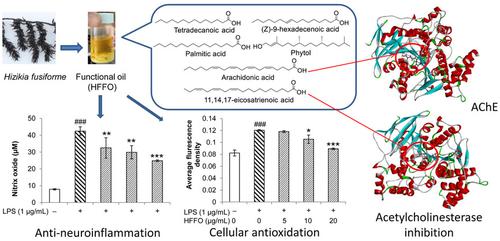当前位置:
X-MOL 学术
›
Chem. Biodivers.
›
论文详情
Our official English website, www.x-mol.net, welcomes your
feedback! (Note: you will need to create a separate account there.)
Chemical Composition and Anti‐Alzheimer's Disease‐related Activities of a Functional Oil from the Edible Seaweed Hizikia fusiforme
Chemistry & Biodiversity ( IF 2.3 ) Pub Date : 2020-07-30 , DOI: 10.1002/cbdv.202000055 Wen-Cong Yang 1, 2, 3 , Yuan-Yuan Zhang 1, 2 , Ya-Juan Li 2 , Ying-Ying Nie 2 , Jin-Yue Liang 1, 2 , Ya-Yue Liu 1, 2 , Jing-Shan Liu 1, 2 , Yong-Ping Zhang 1, 2 , Cai Song 1, 2 , Zhong-Ji Qian 1, 4 , Yi Zhang 1, 2
Chemistry & Biodiversity ( IF 2.3 ) Pub Date : 2020-07-30 , DOI: 10.1002/cbdv.202000055 Wen-Cong Yang 1, 2, 3 , Yuan-Yuan Zhang 1, 2 , Ya-Juan Li 2 , Ying-Ying Nie 2 , Jin-Yue Liang 1, 2 , Ya-Yue Liu 1, 2 , Jing-Shan Liu 1, 2 , Yong-Ping Zhang 1, 2 , Cai Song 1, 2 , Zhong-Ji Qian 1, 4 , Yi Zhang 1, 2
Affiliation

|
Cholinergic disorder, oxidative stress, and neuroinflammation play important roles in the pathology of Alzheimer's disease. To explore the healthy potential of the edible seaweed Hizikia fusiforme on this aspect, a functional oil (HFFO) was extracted from this alga and investigated on its constituents by gas chromatography-mass spectrometry (GC-MS) in this study. Its anti-Alzheimer's related bioactivities including acetylcholinesterase (AChE) inhibition, antioxidation, and anti-neuroinflammation were evaluated, traced, and simulated by in vitro and in silico methods. GC-MS analysis indicated that HFFO mainly contained arachidonic acid (ARA), 11,14,17-eicosatrienoic acid (ETrA), palmitic acid, phytol, etc. HFFO showed moderate AChE inhibition and antioxidant activity. Bioactivity tracing using commercial standards verified that AChE inhibition of HFFO mainly originated from ARA and ETrA, whereas antioxidant activity mainly from ARA. Lineweaver-Burk plots showed that both ARA and ETrA are noncompetitive AChE inhibitors. A molecular docking study demonstrated low CDOCKER interaction energy of -26.33 kcal/mol for ARA and -50.36 kcal/mol for ETrA when interacting with AChE and multiple interactions in the ARA (or ETrA)-AChE complex. In the anti-neuroinflammatory evaluation, HFFO showed no toxicity toward BV-2 cells at 20 μg/mL and effectively inhibited the production of nitroxide and reduced the level of reactive oxygen species in liposaccharide-induced BV-2 cells. The results indicated that HFFO could be used in functional foods for its anti-Alzheimer's disease-related activities.
中文翻译:

一种食用海藻丝状海藻功能油的化学成分和抗阿尔茨海默病相关活性
胆碱能障碍、氧化应激和神经炎症在阿尔茨海默病的病理学中起着重要作用。为了探索食用海藻梭形海藻在这方面的健康潜力,从该藻类中提取了一种功能油 (HFFO),并在本研究中通过气相色谱-质谱法 (GC-MS) 对其成分进行了研究。其抗阿尔茨海默病的相关生物活性包括乙酰胆碱酯酶 (AChE) 抑制、抗氧化和抗神经炎症,通过体外和计算机方法进行评估、追踪和模拟。GC-MS分析表明HFFO主要含有花生四烯酸(ARA)、11,14,17-二十碳三烯酸(ETrA)、棕榈酸、植醇等。HFFO表现出中等的AChE抑制和抗氧化活性。使用商业标准进行的生物活性追踪证实,HFFO 的 AChE 抑制主要来自 ARA 和 ETrA,而抗氧化活性主要来自 ARA。Lineweaver-Burk 图显示 ARA 和 ETrA 都是非竞争性 AChE 抑制剂。一项分子对接研究表明,当与 ARA(或 ETrA)-AChE 复合物中的 AChE 和多重相互作用相互作用时,ARA 的 CDOCKER 相互作用能量为 -26.33 kcal/mol,ETrA 为 -50.36 kcal/mol。在抗神经炎症评估中,HFFO 在 20 μg/mL 时对 BV-2 细胞没有毒性,并有效抑制了氮氧化物的产生并降低了脂糖诱导的 BV-2 细胞中活性氧的水平。结果表明,HFFO因其抗阿尔茨海默病相关活性可用于功能性食品。
更新日期:2020-07-30
中文翻译:

一种食用海藻丝状海藻功能油的化学成分和抗阿尔茨海默病相关活性
胆碱能障碍、氧化应激和神经炎症在阿尔茨海默病的病理学中起着重要作用。为了探索食用海藻梭形海藻在这方面的健康潜力,从该藻类中提取了一种功能油 (HFFO),并在本研究中通过气相色谱-质谱法 (GC-MS) 对其成分进行了研究。其抗阿尔茨海默病的相关生物活性包括乙酰胆碱酯酶 (AChE) 抑制、抗氧化和抗神经炎症,通过体外和计算机方法进行评估、追踪和模拟。GC-MS分析表明HFFO主要含有花生四烯酸(ARA)、11,14,17-二十碳三烯酸(ETrA)、棕榈酸、植醇等。HFFO表现出中等的AChE抑制和抗氧化活性。使用商业标准进行的生物活性追踪证实,HFFO 的 AChE 抑制主要来自 ARA 和 ETrA,而抗氧化活性主要来自 ARA。Lineweaver-Burk 图显示 ARA 和 ETrA 都是非竞争性 AChE 抑制剂。一项分子对接研究表明,当与 ARA(或 ETrA)-AChE 复合物中的 AChE 和多重相互作用相互作用时,ARA 的 CDOCKER 相互作用能量为 -26.33 kcal/mol,ETrA 为 -50.36 kcal/mol。在抗神经炎症评估中,HFFO 在 20 μg/mL 时对 BV-2 细胞没有毒性,并有效抑制了氮氧化物的产生并降低了脂糖诱导的 BV-2 细胞中活性氧的水平。结果表明,HFFO因其抗阿尔茨海默病相关活性可用于功能性食品。











































 京公网安备 11010802027423号
京公网安备 11010802027423号